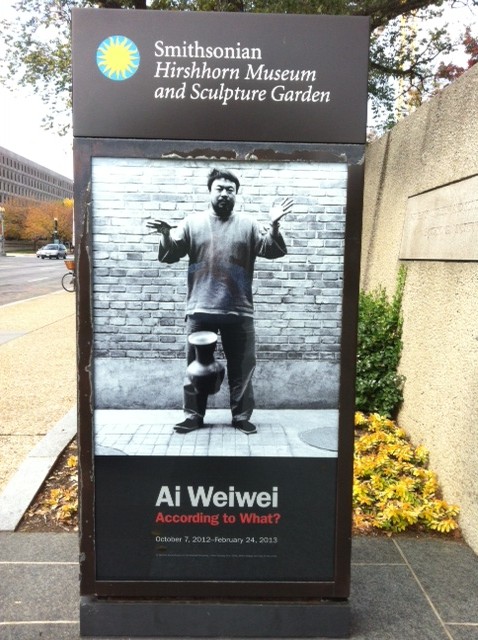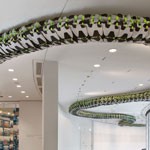I know next to nothing about contemporary art.
And that might be giving myself too much credit.
Probably the last period in art that I understood was the Impressionists. Since then, I’m clueless.
That is by way of introduction and warning to today’s post about an exhibit at Washington, DC’s Hirshhorn Museum.
My sister-in-law was in DC recently, and I hold her responsible, and thank her, for getting me to this exhibit: Ai Weiwei – According to What?
Ai Weiwei is apparently the most popular contemporary Chinese artist whose work is known both within and beyond China (I had never heard of him). He is recognized (and feared by the Chinese authorities and regarded as a dissident) for what his art represents: “freedom of expression and the role of art and artists in affecting social change.” And last year ArtReview named him the most powerful artist in the world. (OK. Now I’m ashamed I never heard of him.)
I have no idea if ArtReview is correct or not, but I can encourage folks who live in Washington or plan to be here between now and Feb. 24,2013 to spend some time at the Hirschhorn and see for yourselves what you think of his work. (There is also a second exhibit, Perspectives: Ai Weiwei, which I have yet to see, at the Arthur M. Sackler Gallery. It is here until April 7, 2013).
Ai Weiwei’s work is not easily categorized. If the exhibit at the Hirshhorn is a fair representation of what he creates, then I’m not sure what to call him: a sculpturer, an architect, a photographer, a painter, a performer, a woodworker, a potter, or all of the above?
Ai Weiwei, 55, lives and works in a suburb of Beijing today, and is more than just a Chinese dissident, however. One of his recent projects was his collaboration on the Birds Nest stadium for the 2008 Olympics.
I suppose there could be a debate as to whether he is an artist or more of a showman, a political artist (is there such a category?) who expresses himself using various genres. You can decide.
For me, some of the most interesting parts of the Hirshhorn exhibit include:
* a long wall listing the names of each of the 5,000+ school children who died during the Sichuan earthquake in 2008 (reminiscent of Mia Lin’s Vietnam Memorial) and his Snake Ceiling, compiled from the backpacks of children who lost their lives in that earthquake;
* his more than 100 photographs that document his ten years living in the US and his more recent photographs and videos of the changing landscapes of Beijing;
* his moon chests, structures built from huali wood, that show every phase of the moon;
* his Map of China, using salvaged wood from Qing Dynasty temples and constructed using traditional Chinese joinery techniques, and his Kippe, a sort of Chinese puzzle that represents images from his past and is also constructed from Qing Dynasty salvaged wood;
* his sculptures, including his Circle of Animals/Zodiac Heads, in the courtyard between the museum and the sculpture garden, and his Teahouse.
To read more about Ai Weiwei, his work, and his current exhibit, see this recent article in the Smithsonian magazine and this article about his According to What? exhibit at the Hirshhorn. Also, see his own statement about this exhibit.
If you get to the Hirshhorn and/or if you have some knowledge and thoughts about Ai Weiwei’s work, I’d be interested in learning what you think.
 Update: 7/22/2015 – For further information and to keep up-to-date on activities and information about Ai Wei Wei and his work, check out his page at check out his page at: https://www.artsy.net/
Update: 7/22/2015 – For further information and to keep up-to-date on activities and information about Ai Wei Wei and his work, check out his page at check out his page at: https://www.artsy.net/






Fruzsina Harsanyi said:
Ray and I have been following Ai Weiwei since we saw his installation of millions of handpainted porcelain sunflower seeds at the Tate Modern in 2010. He thereby employed — and revived– a whole village that used to make porcelain for the emperor. Peter Schjeldahl in The New Yorker asks if he’s a political artist or an artful politician? He’s probably both. While his art is not groundbreaking or “new,” it is often memorable, both for how well it’s crafted and for the message behind the craft. That’s more than one can say for many contemporary artists (and we see a lot of them) with their self-important, pseudo-philosophical statements of work. Ai Weiwei’s art, while not great, is always interesting and his contribution as a political activist who uses his art is important.
We should also note that this is an important exhibit for the Hirshhorn because it lifts this museum exhibit out of the generally boring fare that comes to Washington. I for one have had enough of yet another Impressionist exhibit. Richard, thanks for calling attention to Ai Weiwei and welcome to the 21st century!
MukeJosy said:
Your experience at the art exiibht was a lot like the one described by Falk and Dierking in The Museum Experience (which I read in Spring 2011 for Crew’s Museum Studies class). They found that no visitors, except children, would touch exiibhts which they intended to be touched. This was in spite of signs saying that you could. So the exiibht creators provided the scaffolding for individual interaction with the potential to make that interaction social but people still did not behave that way. Perhaps this points to a problem which Shirky called the milkshake mistake. We need to be sure to account social behavior into our projects as tools alone will not create behavior.